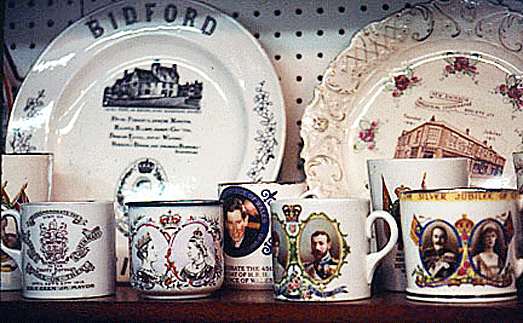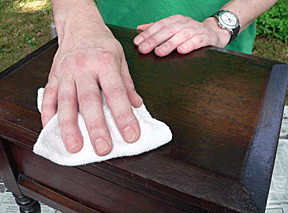|
An Introduction to Caring
for Your
Collections
by
Bob Brooke
 Youíve
taken the time and expense to create your collection. To ensure that it
holds its value, itís important to care and protect it. By practicing
certain basic conservation practices, you can make sure your house is a
safe environment for your collection. Youíve
taken the time and expense to create your collection. To ensure that it
holds its value, itís important to care and protect it. By practicing
certain basic conservation practices, you can make sure your house is a
safe environment for your collection.
Maintaining a consistent temperature of around
70 degrees during both the winter and summer months is most important,
especially with furniture and items made of wood. Veneered furniture is
particularly vulnerable to dampness.
Try not to place objects near vents where they
may be in the direct path of hot or cold air. Also, keep items out of
the path of direct sunlight, particularly paintings, works on paper,
textiles, and furniture. Lastly, reduce the amount of exposure to
natural light by partly lowering shades, drawing curtains, or closing
blinds.
Storing Your Collection
Sometimes a collection becomes so large that items need to be stored.
Always select a dry, clean space in which the temperature remains fairly
consistent. If possible, avoid storing objects in attics, basements, and
garages. Plastic storage bins are excellent for smaller objects like
cameras and provide a watertight and airtight seal.
 When storing objects that must be wrapped or
placed in boxes, be sure to use acid-free materials. Paper and cardboard
products are made with acids that hasten the deterioration of objects
that come into contact with them. For this reason, itís best to avoid
either wrapping objects in newspaper and normal tissue paper or placing
them in old cartons. A number of companies make acid-free tissue paper
and boxes for the safe storage of artwork and smaller antiques that can
be easily wrapped and boxed. When storing objects that must be wrapped or
placed in boxes, be sure to use acid-free materials. Paper and cardboard
products are made with acids that hasten the deterioration of objects
that come into contact with them. For this reason, itís best to avoid
either wrapping objects in newspaper and normal tissue paper or placing
them in old cartons. A number of companies make acid-free tissue paper
and boxes for the safe storage of artwork and smaller antiques that can
be easily wrapped and boxed.
Fragile objects made of glass, pottery or
porcelain should never be stacked on top of each other inside a box.
Attempt to arrange everything in the box in one layer. Under-the-bed
plastic storage bins are best.
If at all possible, store objects on open
shelves instead of crowding them into a box. When objects are evenly
spaced on shelves, the potential for damage is greatly reduced.
Tablewares such as plates, bowls, and cups
& saucers are frequently stacked in boxes or on shelves. When the
pieces rub against each other, surface decoration can easily be removed
in the process. To avoid this problem, place acid-free tissue paper
under each piece in the stack. The tissue paper provides a buffer
between objects that come into contact with each other. Also, make
certain that the stacks donít reach teetering heights! Otherwise,
everything can come tumbling down.
You should never stack or jam furniture into a
tight space in which the pieces bang against each other. Otherwise, you
risk scratching, gauging, or splitin g it. Arrange all furniture
directly on the floor with space between each piece.
Cleaning
Your
Collection
Use a dry paintbrush with soft bristles to dust porcelain, pottery, and
glass objects. A cloth may snag on small details and cause breakage. For
tight areas or small details use pressurized air.
 When cleaning silver and silverplate, try to
avoid using creams and polishes that must be rubbed onto the object to
avoid scratching. Instead, use a solution into which the object can be
dipped to remove tarnish and dirt. This approach is particularly
advisable for silver with gilding or silverplate. Constant rubbing with
a cream or polish will eventually cause the gilding or silver plating to
wear away. When cleaning silver and silverplate, try to
avoid using creams and polishes that must be rubbed onto the object to
avoid scratching. Instead, use a solution into which the object can be
dipped to remove tarnish and dirt. This approach is particularly
advisable for silver with gilding or silverplate. Constant rubbing with
a cream or polish will eventually cause the gilding or silver plating to
wear away.
Never clean antique furniture with a damp
cloth. This can result in the removal of the surface finish and cause
the wood to expand and then contract. Always use a soft, dry cloth or a
paintbrush with soft bristles.
Gilding on furniture should never be polished,
as this will result in the removal of the gilding. Simply leave the
gilding in the condition in which it was found.
Making Repairs & Restorations
You should always consult with a professional on the repair or
conservation of an antique thatís severely damaged or in poor
condition. The professional will know exactly what measures to take. A
home repair could result in even greater damage and will lower the value
of a fine antique.
<
Back to Caring for Your Collections
Archives
Next Article > |
